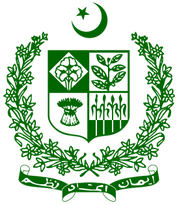National Symbols of Pakistan
Quick Facts
|
Flag
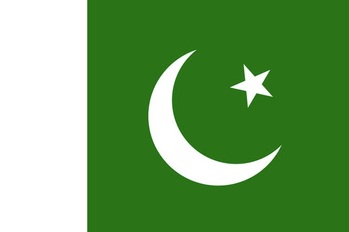
Sabz Hilali Parcham and Parcham-e-Sitara-o-Hilal
The national flag of Pakistan (Urdu: پاکستان کا پرچم) was designed by Syed Amir-uddin Kedwaii and was based on the original flag of the Muslim League, which itself drew inspiration from the flag of the Mughal Empire in India. It was adopted by the Constituent Assembly on August 11, 1947, just days before independence.The flag is referred to in the national anthem as Parcham-e-Sitara-o-Hilal in Urdu (Flag of the Crescent and Star). The flag comprises a dark green field, representing the Muslim majority of Pakistan, with a vertical white stripe in the hoist, representing religious minorities.In the centre is a white crescent moon and a white five-pointed star, which symbolize progress and light respectively.The flag symbolizes Pakistan's commitment to Islam, the Islamic world, and the rights of religious minorities.The flag is flown on several important days of the year including Republic Day and Independence Day. The flag was approved by Muhammad Ali Jinnah, founder of the nation. It is associated with the flag used by the All-India Muslim League as an emblem of its aim of achieving an independent Muslim state. Their flag was green, with a central white star and crescent. At independence in 1947, a white stripe was added at the hoist to represent the state's minorities. The green and white together stand for peace and prosperity. The crescent symbolizes progress, and the star represents light and knowledge.
Qaumi Tarana
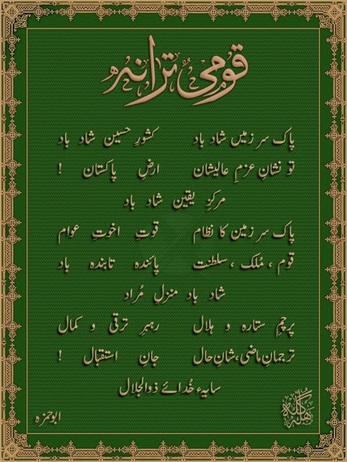
The Qaumi Tarana (Urdu: قومی ترانہ) is the National Anthem of Pakistan. The words "Qaumi Tarana" in Urdu literally translate to "National Anthem". The Pakistani national anthem is unique in that its music preceded its lyrics. At independence, on August 14, 1947, Pakistan did not have a national anthem. When the flag was hoisted at the independence ceremony it was accompanied by the song, "Pakistan Zindabad, Azadi Paendabad". The flag itself had only been approved by the Constituent Assembly of Pakistan three days earlier.Muhammad Ali Jinnah, the founder of Pakistan, asked Lahore-based Hindu writer, Jagannath Azad on August 9, 1947 to write a national anthem for Pakistan in five days.The anthem written by Azad was quickly approved by Jinnah, and it was played on Radio Pakistan.Azad's work remained as Pakistan’s national anthem for approximately eighteen months, despite competition from a rival attempt by B.T. Baghar.
In early 1948, A. R. Ghani from Transvaal, South Africa, offered two prizes of five thousand rupees each for the poet and composer of a new national anthem. The prizes were announced through a Government press note published in June 1948. In December 1948, a National Anthem Committee (NAC) was formed, initially chaired by the Information Secretary, Sheikh Muhammad Ikram. Committee members included several politicians, poets and musicians such as Abdur Rab Nishtar, Ahmed Chagla and Hafeez Jullundhri. The committee had some difficulty at first in finding suitable music and lyrics.
In 1950, the impending state visit of the Shah of Iran, resulted in the Government asking the NAC to submit an anthem without delay. The committee chairman, Federal Minister for Education, Fazlur Rahman, asked several poets and composers to write lyrics but none of the submitted works were deemed suitable. The NAC also examined several different tunes and eventually selected the one presented by Chagla and submitted it for formal approval. Chagla produced the musical composition in collaboration with another committee member and assisted by the Pakistan Navy band.
The music of the anthem was composed by Ahmed Ghulamali Chagla, with lyrics written by Abu-Al-Asar Hafeez Jullundhri. The three stanza composition was officially adopted in 1954. However, the music for the anthem had been composed in 1950 and had been used on several occasions before official adoption. The lyrics allude to a "Sacred Land" referring to Pakistan and a "Flag of the Crescent and Star" referring to the national flag. Unofficially, the anthem is sometimes referred to by its first line "Pak sarzamin shad bad" (Urdu: "Blessed be the sacred land"). The national anthem is played during any event involving the hoisting of the flag, for example Pakistan Day (March 23) and Independence Day (August 14).
The anthem without lyrics was performed for Prime Minister Liaquat Ali Khan and later for the National Anthem Committee on August 10, 1950. Although it was approved for playing during the visit of the Shah, official recognition was not given until August 1954.The anthem was also played during the Prime Minister's visit to the United States. The NAC distributed records of the composed tune amongst prominent poets, who responded by writing and submitting several hundred songs for evaluation by the NAC. Eventually, the lyrics written by Jullundhri were approved and the new national anthem was first played properly on Radio Pakistan on August 13, 1954.Official approval was announced by the Ministry of Information and Broadcasting on August 16, 1954. The composer Chagla had however died in 1953, before the new national anthem was officially adopted. In 1955 there was a performance of the national anthem involving eleven major singers of Pakistan including Ahmad Rushdi.
In early 1948, A. R. Ghani from Transvaal, South Africa, offered two prizes of five thousand rupees each for the poet and composer of a new national anthem. The prizes were announced through a Government press note published in June 1948. In December 1948, a National Anthem Committee (NAC) was formed, initially chaired by the Information Secretary, Sheikh Muhammad Ikram. Committee members included several politicians, poets and musicians such as Abdur Rab Nishtar, Ahmed Chagla and Hafeez Jullundhri. The committee had some difficulty at first in finding suitable music and lyrics.
In 1950, the impending state visit of the Shah of Iran, resulted in the Government asking the NAC to submit an anthem without delay. The committee chairman, Federal Minister for Education, Fazlur Rahman, asked several poets and composers to write lyrics but none of the submitted works were deemed suitable. The NAC also examined several different tunes and eventually selected the one presented by Chagla and submitted it for formal approval. Chagla produced the musical composition in collaboration with another committee member and assisted by the Pakistan Navy band.
The music of the anthem was composed by Ahmed Ghulamali Chagla, with lyrics written by Abu-Al-Asar Hafeez Jullundhri. The three stanza composition was officially adopted in 1954. However, the music for the anthem had been composed in 1950 and had been used on several occasions before official adoption. The lyrics allude to a "Sacred Land" referring to Pakistan and a "Flag of the Crescent and Star" referring to the national flag. Unofficially, the anthem is sometimes referred to by its first line "Pak sarzamin shad bad" (Urdu: "Blessed be the sacred land"). The national anthem is played during any event involving the hoisting of the flag, for example Pakistan Day (March 23) and Independence Day (August 14).
The anthem without lyrics was performed for Prime Minister Liaquat Ali Khan and later for the National Anthem Committee on August 10, 1950. Although it was approved for playing during the visit of the Shah, official recognition was not given until August 1954.The anthem was also played during the Prime Minister's visit to the United States. The NAC distributed records of the composed tune amongst prominent poets, who responded by writing and submitting several hundred songs for evaluation by the NAC. Eventually, the lyrics written by Jullundhri were approved and the new national anthem was first played properly on Radio Pakistan on August 13, 1954.Official approval was announced by the Ministry of Information and Broadcasting on August 16, 1954. The composer Chagla had however died in 1953, before the new national anthem was officially adopted. In 1955 there was a performance of the national anthem involving eleven major singers of Pakistan including Ahmad Rushdi.
State Emblem
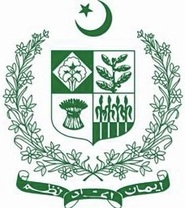
The State Emblem of Pakistan was adopted in 1954. The emblem's green colour and the star and crescent at the top are symbols of Islam, the religion with which most Pakistani citizens identify. In the center is a quartered shield, with each quarter containing a major crop of Pakistan at the time of its adoption: cotton, jute, tea, and wheat. The floral wreath around the shield is Poet's Jasmine (the national flower) and represents the Mughal cultural heritage of Pakistan. The scroll at the bottom contains the national motto in Urdu, coined by Muhammad Ali Jinnah, which reads from right to left: (Urdu: ایمان ، اتحاد ، نظم) Iman, Ittehad, Nazm translated as "Faith, Unity, Discipline".
National Animal

The Markhor (Capra falconeri) is a large goat. It is found in woodland in the Western Himalayas of Afghanistan, Pakistan and Kashmir.
Markhor are 65 to 115 centimetres tall at the shoulder. They usually weigh from 40 to 110 kilograms. Females are a tan colour with a white underbelly and a pattern of black and white on the legs. Males are a lighter tan colour with the same white underbelly and pattern on the legs. Males also have a black face and lots of long white fur on their neck and chest which can grow down to their knees. Both males and females have corkscrew-shaped horns which can grow up to 160 cm / 64 inches long in males, and up to 25 cm / 10 inches in females.
Markhor live in places 500 to 3500 metres (1,500 to 11,000 feet) high, where they eat grass, leaves. Markhor often stand on their back legs to reach the top leaves of trees. Markhor are active (move around more) in the early morning and late afternoon. Females gather in herds (groups) of up to nine animals. Males usually live alone.
The Markhor is the National animal of Pakistan. The word "Markhor" is Persian for "Snake Eater". They mostly live in the Northern Areas of Pakistan especially in the Chitral, Ghizar and Hunza regions. There are about 2000 - 4000 Markhor in the wild.
Markhor are 65 to 115 centimetres tall at the shoulder. They usually weigh from 40 to 110 kilograms. Females are a tan colour with a white underbelly and a pattern of black and white on the legs. Males are a lighter tan colour with the same white underbelly and pattern on the legs. Males also have a black face and lots of long white fur on their neck and chest which can grow down to their knees. Both males and females have corkscrew-shaped horns which can grow up to 160 cm / 64 inches long in males, and up to 25 cm / 10 inches in females.
Markhor live in places 500 to 3500 metres (1,500 to 11,000 feet) high, where they eat grass, leaves. Markhor often stand on their back legs to reach the top leaves of trees. Markhor are active (move around more) in the early morning and late afternoon. Females gather in herds (groups) of up to nine animals. Males usually live alone.
The Markhor is the National animal of Pakistan. The word "Markhor" is Persian for "Snake Eater". They mostly live in the Northern Areas of Pakistan especially in the Chitral, Ghizar and Hunza regions. There are about 2000 - 4000 Markhor in the wild.
National Bird
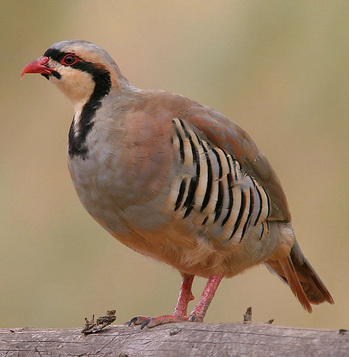
The Chukar (Alectoris chukar) is a Eurasian upland gamebird in the pheasant family Phasianidae of the order Galliformes, gallinaceous birds. Other common names of this bird include 'Chukker' (sometimes misspelled as 'Chuker'), 'Chukar Partridge', 'Red-legged Partridge', 'Rock Partridge', 'Indian Hill Partridge', 'Chukka', 'Chukkar', 'Chukor', 'Chukore', 'Chikone', 'Kabk', 'Kau-Kau', and 'Keklik'. The Chukar is the National Bird of Pakistan.
This partridge has its native range in Asia from Pakistan and Kashmir, and Afghanistan in the east to southeastern Europe in the west, and is closely related and similar to its western equivalent, the Red-legged Partridge, Alectoris rufa. It has been introduced widely, and became established in the United States, Canada, New Zealand and Hawaii. In Great Britain, hybrids between this species and the also introduced Red-legged Partridge are common.
This partridge has its native range in Asia from Pakistan and Kashmir, and Afghanistan in the east to southeastern Europe in the west, and is closely related and similar to its western equivalent, the Red-legged Partridge, Alectoris rufa. It has been introduced widely, and became established in the United States, Canada, New Zealand and Hawaii. In Great Britain, hybrids between this species and the also introduced Red-legged Partridge are common.
National Flower
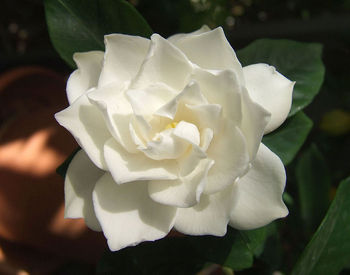
Gardenia (Jasmine) is a genus of 142 species of flowering plants in the coffee family, Rubiaceae, native to the tropical and subtropical regions of Africa, southern Asia, Australasia and Oceania. Several species occur on Hawaii, where gardenias are known as natu or nanu.
The genus was named by Carl Linnaeus after Dr. Alexander Garden (1730-1791), a Scottish-born American naturalist.
They are evergreen shrubs and small trees growing to 1–15 metres (3.3–49 ft) tall. The leaves are opposite or in whorls of three or four, 5–50 centimetres (2.0–20 in) long and 3–25 centimetres (1.2–9.8 in) broad, dark green and glossy with a leathery texture. The flowers are solitary or in small clusters, white, or pale yellow, with a tubular-based corolla with 5-12 lobes (petals) from 5–12 centimetres (2.0–4.7 in) diameter. Flowering is from about mid-spring to mid-summer and many species are strongly scented.
The genus was named by Carl Linnaeus after Dr. Alexander Garden (1730-1791), a Scottish-born American naturalist.
They are evergreen shrubs and small trees growing to 1–15 metres (3.3–49 ft) tall. The leaves are opposite or in whorls of three or four, 5–50 centimetres (2.0–20 in) long and 3–25 centimetres (1.2–9.8 in) broad, dark green and glossy with a leathery texture. The flowers are solitary or in small clusters, white, or pale yellow, with a tubular-based corolla with 5-12 lobes (petals) from 5–12 centimetres (2.0–4.7 in) diameter. Flowering is from about mid-spring to mid-summer and many species are strongly scented.
National Tree
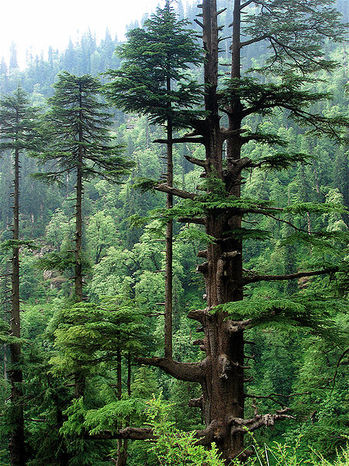
Cedrus deodara (Deodar Cedar, Himalayan Cedar, or Deodar; Urdu: ديودار deodar; Hindi, Sanskrit: devadaru; Chinese: xue song) is a species of cedar native to the western Himalayas in eastern Afghanistan, northern Pakistan, north-central India (Himachal Pradesh, Uttarakhand and Kashmir), southwesternmost Tibet and western Nepal, occurring at 1500–3200 m altitude. It is a large evergreen coniferous tree reaching 40–50 m tall, exceptionally 60 m, with a trunk up to 3 m diameter. It has a conic crown with level branches and drooping branchlets.
The leaves are needle-like, mostly 2.5–5 cm long, occasionally up to 7 cm long, slender (1 mm thick), borne singly on long shoots, and in dense clusters of 20-30 on short shoots; they vary from bright green to glaucous blue-green in colour. The female cones are barrel-shaped, 7–13 cm long and 5–9 cm broad, and disintegrate when mature (in 12 months) to release the winged seeds. The male cones are 4–6 cm long, and shed their pollen in autumn.
The leaves are needle-like, mostly 2.5–5 cm long, occasionally up to 7 cm long, slender (1 mm thick), borne singly on long shoots, and in dense clusters of 20-30 on short shoots; they vary from bright green to glaucous blue-green in colour. The female cones are barrel-shaped, 7–13 cm long and 5–9 cm broad, and disintegrate when mature (in 12 months) to release the winged seeds. The male cones are 4–6 cm long, and shed their pollen in autumn.
National Juice
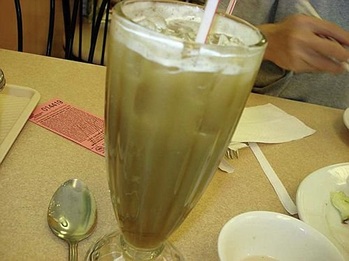
Sugar cane juice is the national drink of Pakistan, where it is called Roh. It is sold fresh by roadside vendors only, as the juice begins turning black very quickly due to oxidation. It is sold in glasses with or without ice.
National Dress
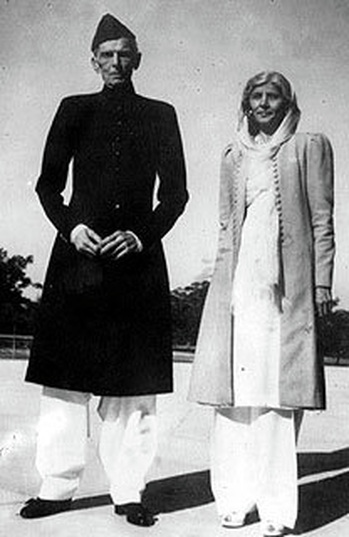
Founder of Pakistan, With his sister Fatima Jinnah, in shalwar qamiz. 1947.
The pants, or salvar, are known as salvar in Punjabi: ਸਲਵਾਰ ਕ਼ਮੀਜ਼, salvaar or shalvaar શલવાર કમીઝ in Gujarati, salvaar or shalvar शलवार क़मीज़ in Hindi, and shalvar in Urdu: شلوار قمیض. The word comes from the Persian: شلوار, meaning pants.
Salwar kameez is a traditional dress worn by both women and men in Southern Asia. Salvars or shalvars are loose pajama-like trousers. The legs are wide at the top, and narrow at the bottom. The kameez is a long shirt or tunic. The side seams (known as the chaak) are left open below the waist-line, which gives the wearer greater freedom of movement. It is the most common dress for men in Pakistan and Afghanistan.
Salwar kameez is a traditional dress worn by both women and men in Southern Asia. Salvars or shalvars are loose pajama-like trousers. The legs are wide at the top, and narrow at the bottom. The kameez is a long shirt or tunic. The side seams (known as the chaak) are left open below the waist-line, which gives the wearer greater freedom of movement. It is the most common dress for men in Pakistan and Afghanistan.

